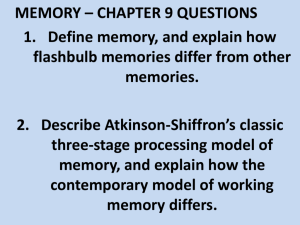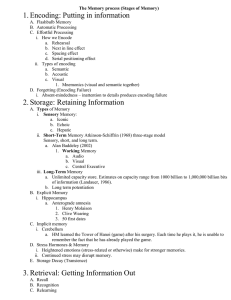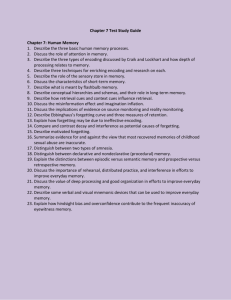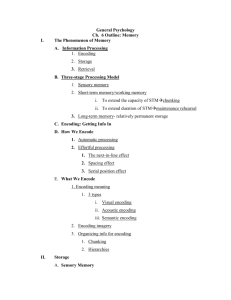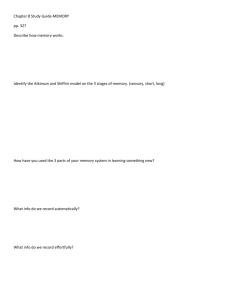Memory
advertisement
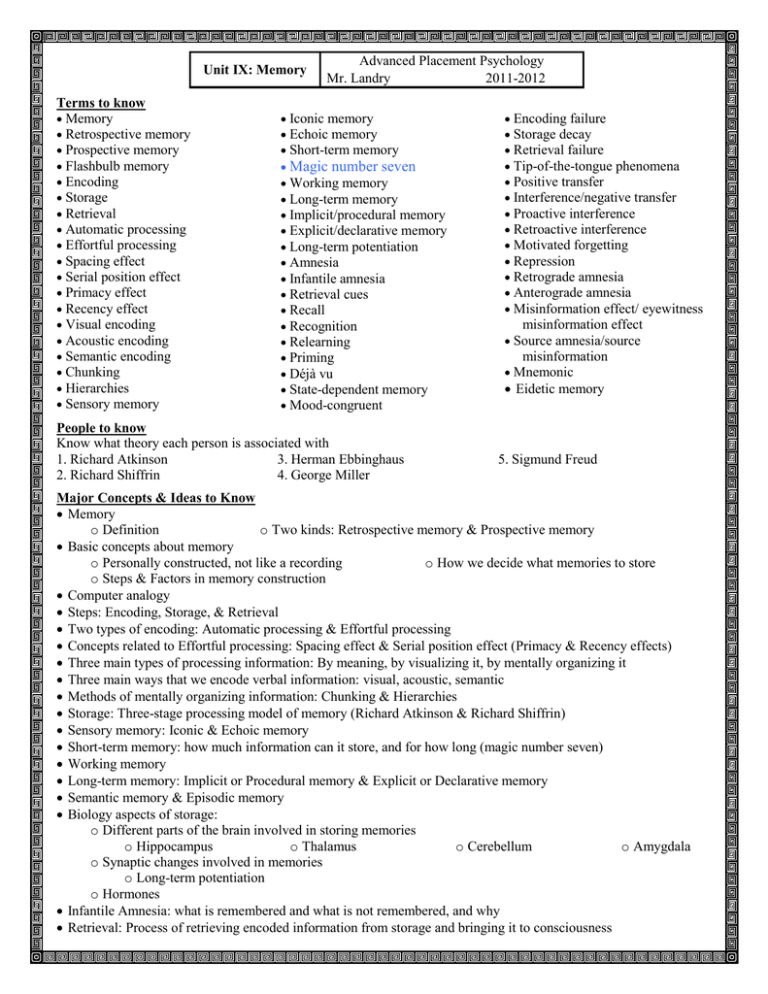
Unit IX: Memory Terms to know Memory Retrospective memory Prospective memory Flashbulb memory Encoding Storage Retrieval Automatic processing Effortful processing Spacing effect Serial position effect Primacy effect Recency effect Visual encoding Acoustic encoding Semantic encoding Chunking Hierarchies Sensory memory Advanced Placement Psychology Mr. Landry 2011-2012 Iconic memory Echoic memory Short-term memory Magic number seven Working memory Long-term memory Implicit/procedural memory Explicit/declarative memory Long-term potentiation Amnesia Infantile amnesia Retrieval cues Recall Recognition Relearning Priming Déjà vu State-dependent memory Mood-congruent People to know Know what theory each person is associated with 1. Richard Atkinson 3. Herman Ebbinghaus 2. Richard Shiffrin 4. George Miller Encoding failure Storage decay Retrieval failure Tip-of-the-tongue phenomena Positive transfer Interference/negative transfer Proactive interference Retroactive interference Motivated forgetting Repression Retrograde amnesia Anterograde amnesia Misinformation effect/ eyewitness misinformation effect Source amnesia/source misinformation Mnemonic Eidetic memory 5. Sigmund Freud Major Concepts & Ideas to Know Memory o Definition o Two kinds: Retrospective memory & Prospective memory Basic concepts about memory o Personally constructed, not like a recording o How we decide what memories to store o Steps & Factors in memory construction Computer analogy Steps: Encoding, Storage, & Retrieval Two types of encoding: Automatic processing & Effortful processing Concepts related to Effortful processing: Spacing effect & Serial position effect (Primacy & Recency effects) Three main types of processing information: By meaning, by visualizing it, by mentally organizing it Three main ways that we encode verbal information: visual, acoustic, semantic Methods of mentally organizing information: Chunking & Hierarchies Storage: Three-stage processing model of memory (Richard Atkinson & Richard Shiffrin) Sensory memory: Iconic & Echoic memory Short-term memory: how much information can it store, and for how long (magic number seven) Working memory Long-term memory: Implicit or Procedural memory & Explicit or Declarative memory Semantic memory & Episodic memory Biology aspects of storage: o Different parts of the brain involved in storing memories o Hippocampus o Thalamus o Cerebellum o Amygdala o Synaptic changes involved in memories o Long-term potentiation o Hormones Infantile Amnesia: what is remembered and what is not remembered, and why Retrieval: Process of retrieving encoded information from storage and bringing it to consciousness Types of Retrieval: Recall, Recognition, Relearning Eidetic memory: what it is & why it is not necessarily a good thing Retrieval Cues: what they are & kinds o Words o Pictures o Flashbulb memory o Events o Context effects o Moods: State-dependant memory & Mood-congruent Forgetting Why forgetting a good thing Theories involving forgetting: Encoding failure, Storage decay, Interference/negative transfer, & Motivated forgetting (repression) o Interference/negative transfer: Proactive & Retroactive interference o Motivated forgetting (repression): what it is, reasons for it, & who came up with it Amnesia: definition, what it effects, & kinds (Retrograde & Anterograde amnesia) Memory construction: how we contract memories & what effects their construction How memories can be encoded & retrieved incorrectly & how that effects memory Source amnesia/source misattribution: what it is & examples of it How/why encoding & retrieval errors happen (conscious vs. unconscious) What effects encoding/retrieval errors Bold-Faced Words (BFW’s) You do need to know these for the test, even if they are not listed above. 1. Acoustic encoding 14. Implicit/procedural memory 2. Amnesia 15. Long-term memory 3. Automatic processing 16. Long-term potentiation 4. Chunking 17. Memory 5. Déjà vu 18. Misinformation effect/eyewitness 6. Echoic memory misinformation effect 7. Effortful processing 19. Mnemonic 8. Encoding 20. Mood-congruent 9. Explicit/declarative memory 21. Priming 10. Flashbulb memory 22. Proactive interference 11. Hippocampus 23. Recall 12. Iconic memory 24. Recognition 13. imagery 25. Rehearsal Vocabulary Due the day of the test 1. Anterograde amnesia 2. Eidetic memory 3. Encoding failure 4. Interference/negative transfer 5. Motivated forgetting 6. Positive transfer 7. Primacy effect 8. Prospective memory 9. Recency effect 10. Retrieval failure 11. Retrograde amnesia 12. Retrospective memory 26. Relearning 27. Repression 28. Retrieval 29. Retroactive interference 30. Semantic encoding 31. Sensory memory 32. Serial position effect 33. Short-term memory 34. Source amnesia/source misinformation 35. Spacing effect 36. Storage 37. Visual encoding 13. State-dependent memory 14. Storage decay 15. Tip-of-the-tongue phenomena 16. Working memory Unit VIII test question breakdown: Versions A & B Background: 1, 2 Non-associative learning - terms: 3 – 5 Associative learning - terms: 6 Classical conditioning - terms: 6 Classical conditioning – identifying responses & stimuli: 7 – 18, 25 Classical conditioning – related terms: 19 – 27, 98 Classical conditioning – different variables that affect conditioning: 28 – 34 Operant conditioning – background: 35, 83, 84 Operant conditioning – reinforcer vs. punishment/positive vs. negative: 36 – 37, 60 - 69 Operant conditioning – successive approximations: 38, 40 Operant conditioning – shaping: 39, 40 Operant conditioning – related terms: 41, 42 Operant conditioning – intrinsic vs. extrinsic motivation: 43, 44 Operant conditioning – primary vs. secondary reinforcer: 45 Operant conditioning – immediate vs. delayed reinforcers: 46, 49, 81 Operant conditioning – continuous vs. intermittent reinforcers: 47, 48 Operant conditioning – ratio schedule: 50 – 59, 67 - 69, 96 Operant conditioning – different variables that affect conditioning: 70 – 71 Observational learning - latent learning: 72 Observational learning - modeling: 73, 79, 80, 89 Observational learning – mirror neurons: 74 Identifying type of learning: 75 – 80, 92-96 Experiments: 80, 85, 86, 88, 90, 91 Psychologists: 82 - 90 Behaviorism – definition: 82 - 84 Perspectives: 87 Previous Units – parts of the nervous system: 97 Conditioning – most efficient schedule of reinforcement: 99 Previous Units – tardive dyskinesia: 100 Reading assignment due dates Assignment Outline/BFT (Unit IX: Memory) 343361 Reading/BFT (Unit IX: Memory) 361381 Topics covered Background, encoding, storage Retrieval, forgetting, memory construction Unit IX: test/vocab Due date “A” Day “B” Day Monday, Friday, January 9th January 6th Wednesday, Tuesday, January 11th January 10th Friday, January 13th Thursday, January 12th Please note that this schedule is different than the one on the Unit VII Guide As you are reading this unit… Take note of the following major ideas and concepts and make sure you include them in your outline and understand them. Memory Loss and Memory Feats (page 344) What is flashbulb memory? Information processing (page 345) What are the three steps of information processing? What does each of these steps do? What is the three-stage processing model of memory? o Who are the psychologists associated with it? o Do not mix up the three steps of information processing and the three stage-processing model. o What are each of the three stages? o Which of the three steps is the three-stage processing model associated with? Encoding (page 347) What is encoding? What are the two types of encoding? What are the concepts associated with effortful encoding? Which psychologist is most associated with effortful processing? What We Encode (page 349) What are the three ways we process information? What are the three main kinds of encoding that are used to encode verbal information? Which is considered the best? What are mnemonics? What are the main ways to organize information to better encode it? Storage (page 354) What are the three main types of storage? What is “magic number seven” refer to? What are the two types of sensory memory? Storing Memories in the Brain (page 356) What part does synaptic changes play in memory? What is long-term potentiation (LTP)? What is implicit memory? What is explicit memory? What parts of the brain are most associated with memory? Retrieval (page 361) What is the difference between recall and recognition? Retrieval Cues (page 362) Memory is held in storage by associations. The way we retrieve specific memories is through priming, which is referred to as “the waking of associations” Make sure to understand what context effects are and how mood and memories are related Forgetting (page 365) Understand how forgetting is related to encoding. What is storage decay? What is the Ebbinghaus forgetting curve? Understand how forgetting is related to retrieval. What is the difference between proactive interference and retroactive interference? What is motivated forgetting? Memory construction (page 372) The idea of memory construction can be tricky because it is conceptual. Understand the idea that memories are reconstructive, not reproductive. In other words, we construct our memories, they are not just reproduced like a tape recording. What are the misinformation effect and the imagination effect? What is source amnesia? Is it possible to tell true from false memories? How is that related to the concept of memory construction? How do these concepts relate to repressed memories? Frequently Missed Questions from the Unit VII test Know what things are done at the conscious level; when you’d be most likely to be using the conscious level; and the speed that the conscious level works, as compared to the other levels. Know what an endogenous biorhythm is and examples of it. Know what gland is associated with melatonin and what causes it to be produce that hormone and what causes it to stop production of it. What kind of biorhythm would causes us to resist going to bed/falling asleep earlier than we normally would. Know the different sleep stages especially what waves occur in what stages. Know what when we are in stage two sleep for the second time, the next stages we would be in is REM (1, 2, 3, 4, 3, 2, REM, 2, 3, 4, 3, 2, REM, etc.) and we’re only in Stage 1 sleep once. Know what stage sleepwalking occurs and what brain waves are at that stage. Know the difference between parasomnias and dyssomnias. Know what the term “primary sleep disorder” means and which of the sleep disorders we learned are sometimes not considered primary sleep disorders and why. Know which parts of the brain are most active and which are not active when we are dreaming. Know what Carl Jung is most associated with in terms of dream theory. Know what supports theories that our dreams help to solidify our memories of daytime experiences or try to make sense of our daytime experiences. Know what the Salience Hypothesis is and what regarding dreams it is related to. Know what the characteristics of the brainwaves of someone under hypnosis are Know what category of drug alcohol is, whether it be in small or large amounts Know what amphetamines do to the level of anxiety and how they would affect the sympathetic nervous system. Knowing what category of drugs amphetamines are would help in answering this question. Know what the scientific name and its most common abbreviation for the drug Ecstasy. Know which category of drugs is usually psychologically addictive and not physically addictive. Know what neurotransmitters are most associated with which categories of drugs, and whether each one is an agonists or antagonists. Know what sense the semicircular canals are most associated with. Know the wave information regarding light and sound; especially amplitude and wavelength. The analogies for the waves will be on pretty much every test, so make sure you know the wave information. Know what transduction is and where it takes place for each of the senses. In other words, know what the sensory receptors are for each of the senses. Know the difference between rods and cones, not just that one can sense color and one can sense only black & white. Know what heritability is. If given an example, know if it is negative correlation or positive correlation.


